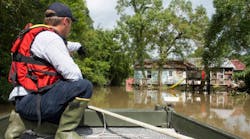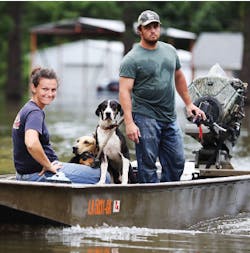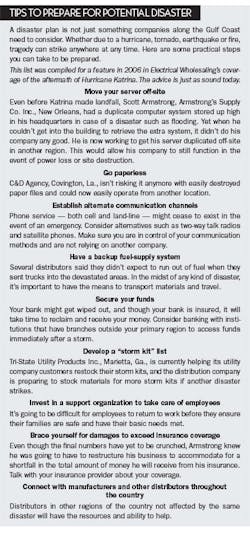Sponsored
It was clear soon after the rain began to fall that this wasn’t just a normal storm.
“It was one of those weird events no one saw coming,” says Leland Sonnier, service center leader for Summit Electric Supply’s branch in Broussard, La., near Lafayette. “About an hour into it, you saw the water piling up about three inches an hour, and you knew this wasn’t a traditional type of rain. This was something totally different.”
The storm blew in Aug. 11, a series of rain bands that stalled over one area for about 36 hours, dumping over 30 inches of rain in some parts of Louisiana, most heavily northeast of Baton Rouge. The rivers began to crest their banks on Friday Aug. 12 and continued to rise for two more days.
When it was over, thirteen people had died in the floods. An estimated 60,000 homes were damaged. Twenty Louisiana parishes were declared federal disaster areas in the aftermath.
Electrical distributors and reps in Louisiana tell us that people in the area are still doing initial cleanup and assessing the damage. Over the next few weeks the rebuilding should begin and distributors are making sure they have plenty of inventory on hand or on order to supply the effort.
None of the distributors and reps we spoke with saw any serious damage to their facilities and none of their employees had been hurt. At Mid-State Supply Co.’s Broussard location, just south of Lafayette, the flood waters rose up the dock but never made it inside the building. Summit Electric Supply’s Gonzales branch saw two feet of water in the parking lot, but it never got close to the building.
The emergency response began immediately. A group of irregulars who call themselves the Cajun Navy, including three employees at Summit Gonzales, started going house-to-house in fishing boats carrying people to safety. “They didn’t wait around for first-responders — for FEMA or the National Guard. They got their boats and went door to door rescuing people out of their houses. Two of our gentlemen rescued 150 people,” said Chip Shows, service center leader for Summit’s Gonzales location.
Sonnier of Summit Broussard lives a mile away in Lake Charles and was unable to get to his branch for several days due to closed and flooded roads. The service center manager of Summit’s Lake Charles branch lives in Lafayette and had the same problem, so they traded places for a few days, Sonnier said.
Even electrical businesses relatively removed from the Baton Rouge area have been affected in different ways. Christopher Cappo, owner of rep agency CEMI-US in Harahan, La., near New Orleans, has three employees in the military reserves who got called-up soon after the floods hit, including two who run CEMI-US’s warehouse. Cappo has thus stepped into a role he doesn’t usually handle, managing the warehouse with the help of some temporary employees and long hours.
“We didn’t hear from anybody in Baton Rouge for a few days, it was just silent. Now it’s just starting to come back,” says Cappo of CEMI-US.
Right now, the bulk of the demand is for temporary power hookups for travel trailers and the FEMA trailers that are beginning to arrive. The impact on the power grid was less than most storms Louisiana sees because there were no hurricane-strength winds knocking out power poles. Utilities shut down some substations pre-emptively and had them back in operation quickly. Now they’re putting temporary power poles in people’s yards to hook up the trailers where residents will live while the recovery proceeds.
Memories of the aftermath of hurricanes Katrina and Rita echoed in everyone’s descriptions. “The severity of the impact on Baton Rouge is expected to be as serious as we saw from Katrina and we’ll have a lot of contractors going down there to help,” says Junior Hebron, VP of sales and marketing for Mid-State Supply. “Experienced, insured, licensed contractors will be in short supply. There’s a whole lot of work to be done.”
“It took five years after Katrina to really make a dent in the rebuilding. The difference here is that Katrina hit a central business district in New Orleans, where there’s a concentration of people and businesses, and a lot of political entities. In this case it’s smaller municipalities with residential and commercial that’s been impacted,” says Cappo. “It’s going to take them two or three months just to get over the shock. In the first six months folks who have the resources to rebuild will do so, they need to put employees back to work. But it will take three to five years to get it functionally back where you can say we’re back up and going.”
Commercial and residential contractors and customers are all busy ripping out drywall and carpet and replacing essentials to get facilities to a condition where it’s at least safe to operate, and will wait to fix the rest of it later.
Once the real work of recovery gets underway, distributors are looking at lots of residential and commercial basic electrical equipment — panel boards, building wire, receptacles, switches and boxes. Distributors say their vendors have been reaching out, offering help, activating emergency policies that put orders from authorized distributors in disaster areas at the top of the list for delivery.
CEMI-US is a stocking rep, so Cappo moved quickly to getting word to his distributors. “We sent an e-mail blast to key distributors telling them what we were doing to get ahead of demand, to make sure if their inventory was affected we have the inventory to back them up and what we’ve got coming in, like multiple truckloads of Romex.”
Distributors themselves have been busy reaching out to their customers with offers of help, whether it’s electrical equipment or sending a truck to deliver water to a customer’s employee who’s stranded. Summit has been sending its own fleet of trucks to pick up material from warehouses as UPS, FedEx and other shipping companies are prioritizing relief supplies.
Outreach and updates from across the electrical industry have been profuse. AD sent out a message telling how its distributor members in the area were affected.
“Several members of AD Electrical have been affected by the flooding in Louisiana. Teche Electric employees in the Baton Rouge area lost everything due to high levels of flood water. Many Teche employees were evacuated out of their homes and sent to shelters. After the storm, many returned to their homes to find devastating water damage, and have spent days cleaning up while they live with family and friends. Many employees did not have property or flood insurance.”
The National Electrical Contractors Association (NECA) was among several groups gathering donations for relief. The National Electrical Manufacturers Association (NEMA) provided updated safety guidelines for electrical equipment damaged in floods.
Sonnier credits Summit’s emergency advance planning with minimizing the disruptions and distress of the disaster. The company had a specific preparedness plan with lists of materials made available to the branches in damaged areas. “What causes fear is when you don’t know what to do,” he said. “Our people knew exactly what to do and that helps.”
“I’ve been in this business for 27 years, and it can be a tough business at times,” Sonnier added. “But in these moments you see vendors and your company reach out and do whatever’s necessary. We’ve had endless e-mails from vendors, suppliers, customers, everyone’s checking on each other, not as vendors but as people. It becomes personal, not just business and that helps build bonds for the future, just on caring and doing what’s right. That’s a silver lining when you have these moments.”




